|
Sun Facts
“Deep beneath the surface of the Sun, enormous forces were gathering. At any moment, the energies of a million hydrogen bombs might burst forth in the awesome explosion…. Climbing at millions of miles per hour, an invisible fireball many times the size of Earth would leap from the Sun and head out across space.“
Arthur C. Clarke
According to Russian solar physicists over a two day period (5/6th December 2006), Sunspots 10929 & 10930 exploded with such force that the combined electromagnetic energy was the biggest outburst in 30 years. If you acquired a sun-tan around about that time, maybe you should consider that you were flash-fried by X-rays, which only take 8 minutes & 20 seconds to arrive from the Sun. Here is a synopsis of stories & information surrounding this major event.
The “Solar Min” Massive blowout at Sunspot 929 & 930
|
Scientists at the Shernberg Astronomy Institute of the Moscow State University reported record-high emissions of electromagnetic
energy on the Sun, the biggest since the 1970s. Over the past few days, the volume of sun radiation, exceeded the normal
level by 1,000-fold. According to these scientists, this kind of activity at solar minimum is quite a phenomena and considered an anomaly as, “Outbursts on the Sun like this have been extremely infrequent over the past 30 years.” Find out more
here, copy here
According to spaceweather.com, Earth-orbiting satellites detected a major X9-class solar flare. Since the source was a sunspot emerging over the Sun's eastern limb, the flare was not Earth-directed. The X-ray image of the blast (adjacent) was captured by NOAA's GOES-13 satellite. Even though there are no SOHO images of this massive event and no mention of a Bakeout, initial reports suggested that the SOHO satellite was taken offline as a precautionary measure.
|
|
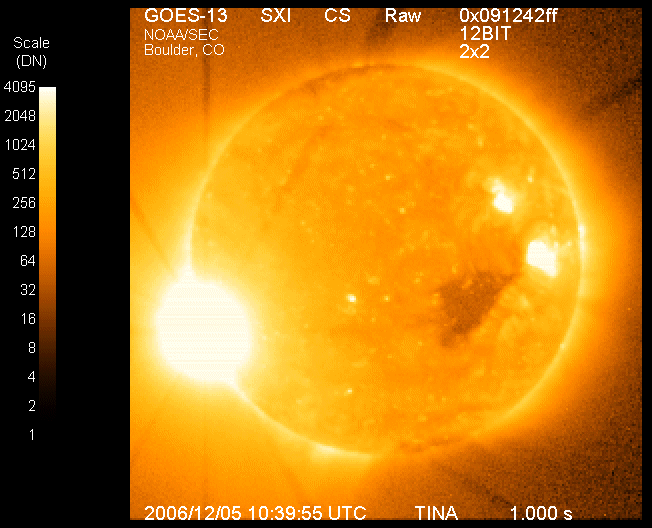
Major X9-class solar flare
|
|
From the report , this event caused “significant events worldwide”. Solar physicist Dale Gary reports:
“The odd thing about this outburst was that the Sun is supposed to be at the minimum phase of its 11-year cycle,” ...
“Nevertheless, the disruption lasted more than an hour, produced a record amount of radio noise, and caused massive disruptions of Global Positioning Satellite (GPS) receivers world wide.”
Solar physicist says weak sun produces record solar outburst, Physorg.com, Dec 15, 2006
Before the outburst, the radio output of the Sun in the GPS broadcasting band was 54 on the scale of solar flux units. During the outburst, associated with a large solar flare, the radio noise reached around 1 million solar flux units, according OVSA instruments.
“This reading is more than 10 times the previous record, and calls into question scientists' assumptions of the extent to which the Sun can interfere with GPS and wireless communications.”
Source: New Jersey Institute of Technology, Dec 15, Space & Earth science
|
|
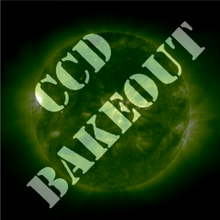
What is a Bakeout?
Click here for more info
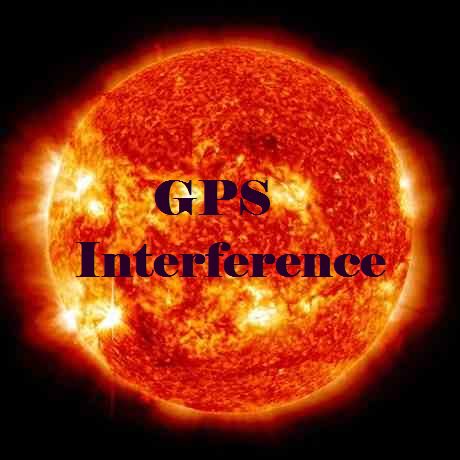
The Rise of GPS interference Click here for more info
|
Have you ever heard the Sun?
|
Using a multi-frequency radiotelescope that has been modified and customized for binaural audio recording it is possible to actually record and hear the massive explosions on the Sun. Here is a collection of specimen sound files of the major types of solar radio emissions of significant events recorded in the past few years. The image of sunspot 930 was also accompanied by a rare tsunami type “Moreton Wave” that rippled across the Sun, for the story from Space.com click here.
|
|
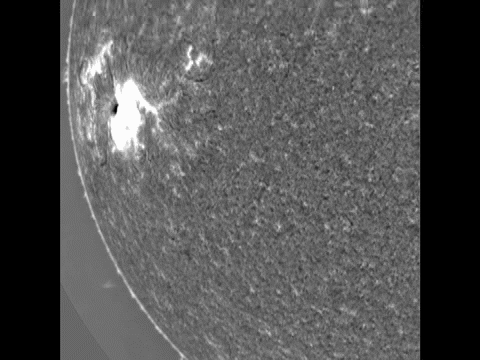
Moreton Wave
Credit: NSO/AURA/NSF
and USAF Research Laboratory
|
Sunspots & Solar Flare Alphabet Soup
|
A sunspot is a dark area of the solar surface, caused by a temperature variation at the photosphere (the visible surface of the Sun or a star). The temperature at the center of a typical sunspot is approximately 4240 kelvins, while the solar photosphere is at approximately 6000 kelvins. A sunspot is approximately 1000 times stronger than the average magnetic field of the Sun and various theories use this magnetic variation to explain why sunspots are areas where as you look down into the Sun, the temperatures are cooler and not hotter as one would expect.
Now that the activity of the Sun has become increasingly unpredictable, scientists are starting to dispel the myth of solar minimum and point out that the most severe x-rated solar flares can occur at any time. Click the adjacent graph to see how often we have been blasted by X-rated flares over the last three solar cycles. The associated article can be found here .
To find out about the classification of X-ray Solar Flares, go to Spaceweather.com “Solar Flare Alphabet Soup”.
|
|
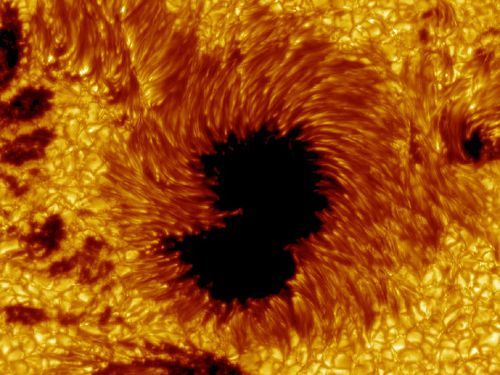 A Sunspot Click here for more information.
A Sunspot Click here for more information.
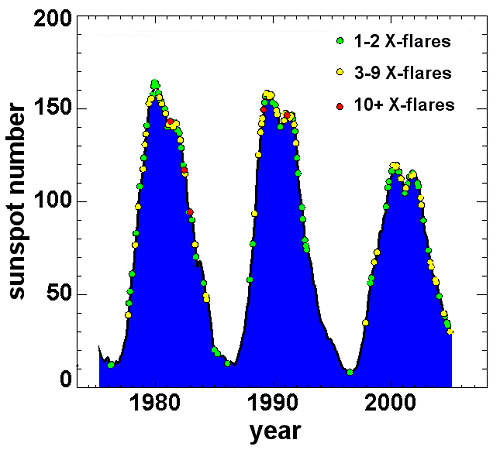
The sunspot count variation over a solar cycle Click image for more information
|
Solar Activity Monitors
|
The X-ray Solar status monitor analyses the status of the previous 24 hours of 5 minute Long-wavelength X-ray data from each satellite (GOES 8 and GOES 10) and an appropriate level of activity for the past 24 hours is assigned.
The Geomagnetic Field status monitor analyses the previous 24 hours of the Kp Index and an appropriate level of activity for the past 24 hours is assigned. The Kp Idex. A 3-hourly planetary geomagnetic index of activity generated in Gottingen, Germany, based on the K Index from 12 or 13 stations distributed around the world. The K index measures the deviation from that of a quiet day at a particular recording station.
You can see what's been happening on the sun in the last few days by watching a video of a compilation of coronagraphs. Click to obtain the Space Weather Explorer window.
|
|
Solar X-rays 
Geomagnetic Field 
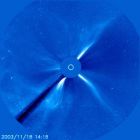
What's happening
with the Sun?
|
NASA predictions of Solar Max in 2012!
|
NASA scientists announced that solar activity will start to dramatically increase from 2007 or 2008 and peak in 2012 and be the most intense solar maximum in fifty years. The prediction comes from a team led by Mausumi Dikpati of the National Center for Atmospheric Research (NCAR), who says “The next sunspot cycle will be 30% to 50% stronger than the previous one”. There was an historic Solar Max in 1958, anything similar will have massive effect on cell phones, GPS, TV Networks, weather satellites and many other modern technologies. Click the Solar Max image for more details of this significant scientific prediction by researchers.
|
|

|
Update: Solar Minimum Confounds NASA Scientists!
|
Since 2004, the sun has been in a prolonged period of low sunspot activity. In March 2009, NASA decided to launch one or more studies about the ongoing solar minimum and solicited proposals. See the article,
NASA solicits new studies on the current solar minimum, from which we can find the following NASA quote;
“In 2009, we are in the midst of the minimum of solar activity that marks the end of Solar Cycle 23. As this cycle comes to an end we are recognizing, in retrospect, that the Sun has been extraordinarily quiet during this particular Solar Cycle minimum. This is evidenced in records of both solar activity and the response to it of the terrestrial space environment.”
Yet this solar minimum has not ended and now there are now two main concerns. 1. We are on the verge of an historic blow out as it is known that the sun can take a long break before extreme activity. 2. This low sunspot activity could lead to global cooling, or a new ice age. See NASA News article, Deep Solar Minimum.
|
|
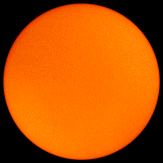
Spotless Sun
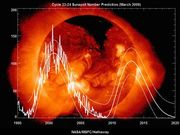
NOAA SWPC Solar Cycle 24 Sunspot Number Prediction, March 2009
|
Update June 2013: Twin Peaks? Solar Maximum Confounds NASA Scientists!
|
In March 2013, yet again, NASA admitted that they were completely flummoxed. From the NASA press release Solar Cycle Update: Twin Peaks? we are informed:
Something unexpected is happening on the sun. 2013 is supposed to be the year of Solar Max, the peak of the 11-year sunspot cycle. Yet 2013 has arrived and solar activity is relatively low. Sunspot numbers are well below their values in 2011, and strong solar flares have been infrequent for many months. [...]
Given the tepid state of solar activity in Feb. 2013, a maximum in May now seems unlikely.
“We may be seeing what happens when you predict a single amplitude and the Sun responds with a double peak,” comments Pesnell.
Incidentally, Pesnell notes a similarity between Solar Cycle 24, underway now, and Solar Cycle 14, which had a double-peak during the first decade of the 20th century. If the two cycles are in fact twins, “it would mean one peak in late 2013 and another in 2015.”
No one knows for sure what the sun will do next. It seems likely, though, that the end of 2013 could be a lot livelier than the beginning.
Source: Solar Cycle Update: Twin Peaks?, NASA Science News, 1st March 2013
In response, a commentator penned:
Altrock noted that Solar Cycle 24 was 40% slower than the average of the previous two cycles. That means that it is going to be 40% longer and that is borne out by the diagram. [...] On this line of evidence, Solar Cycle 24 will be 17 years long and the longest solar cycle for 300 years.
Given the tepid state of solar activity, the belief among solar watchers is that predictions of a peak in May 2013 were unlikely. Solar physicist Dean Pesnell of NASA's Goddard Space Flight Center thinks we are seeing something different to normal. He says, “We may be seeing what happens when you predict a single amplitude and the Sun responds with a double peak.” He notes a similarity between Solar Cycle 24 and Solar Cycle 14, which had a double-peak during the first decade of the 20th century. If the two cycles are twins, it would mean one peak in late 2013 and another in 2015. Read more at NASA Earth Observatory website, A Quiet Interlude in Solar Max
|
|
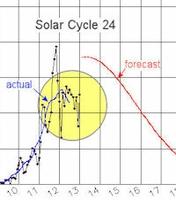
Solar Cycle 24?
It's has now been years of solar scientists trying to figure out what is going on with the Sun. You can find an archive of articles and stories at the News of the Imbalance Blog Sun News & Reports
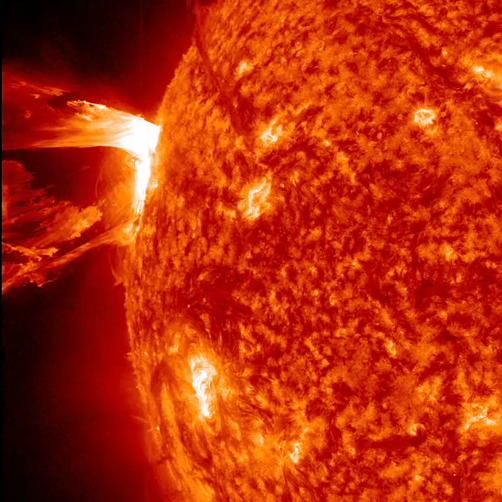
Sunspot 1460 Explodes
This spectacular solar eruption took place when magnetic fields on the sun's northeastern limb erupted around 17:45 UT on April 16th, 2012 producing one of the most visually-spectacular explosions in years. NASA's Solar Dynamics Observatory recorded the blast at extreme ultraviolet wavelengths: Click image to find the video at spaceweather.com.
|
Joyfire Tour Back
  Next
|

